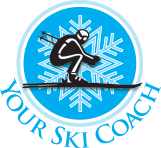When Do We Ski Countered And When Square?
What Rotational State Is Used When In Skiing?
When Do We Ski Countered And When Square?
What Rotational State Is Used When In Skiing?

When do we ski countered and when square? Turn shape, edge angles, terrain, something else…?
Valerie
Counter serves a few important purposes. First, it orientates our pelvis towards the outside of the turn. That allows us to angulate and stay balanced on our outside ski, by flexing forward at the waist, which moves our Center of Mass towards our outside ski. That's in contrast to having to flex sideways at the waist to angulate, as you do when skiing square, with your pelvis facing straight ahead. We have a much greater range of motion when flexing forward at the waist than we do flexing sideways. That means counter provides more potential for strong angulation than does a square stance.
Generally, the more we tip our body into a turn, and the higher we tip our skis on edge, the more we have to angulate to stay balanced on our outside ski. This means higher edge angles generally require more counter, so we can achieve the angulation we need to remain optimally balanced.
The second benefit of counter is that it helps to pronate your outside foot. Pronation directs pressure to the big toe side of the foot. That just happens to be the side of the foot that stands above the turning edge of the outside ski. I's exactly where we want the pressure to be. It only takes a small amount of counter to cause pronation.
The final important application of counter is to produce a body position called "anticipated". We're anticipated, when at the end of a turn our body faces straight down the falline, while our skis are still turning across it. Anticipation creates a rotational torque at our waist that serves to twist our skis into the falline to join our body the moment we release our edges and stop turing. It's something called a pivot, an aggressive redirection of the skis down the falline right at the start of the turn, and anticipation is a very effective way of powering it.
So here's the short answer to when to use counter is. Most turns benefit from using a bit of counter to pronate the outside foot. As edge angles grow, typically when carving, more counter is used to allow for more angulation for maintaining lateral balance. And if we want to pivot the start of a turn we use a lot of counter, right at the end of the turn.
Now, about skiing square. This is where the body faces the same direction as the skis, at all times, as the skis go around the turn. When skiing totally square we loose the pronation effect, but there are some benefits to be had in special situations. As I explained above, counter at the end of a turn can impose a twisting force on the ski that can result in a pivot taking place as you begin the new turn. A pivot is a default nemesis of many recreational skiers. A fear of the falline, or just lack of skills, causes them to throw there tails sideways to start there turns. This default pivot is something that needs to be eliminated during the skill building process. Skiing totally square removes any twisting influence on the skis caused by counter, which makes it easier to learn to shed the pivot.
Finally, when steering turns, a square stance allows the legs to function most effectively. When learning to steer, a square stance is a good place to start. The loss of angulating potential associated with a square stance is not an issue, because steering is generally done on low edge angles, where lateral balance is easy to achieve with minor amounts of angulation.
Once a skier becomes more skilled, they will be able to introduce a little counter into their steered turns, regaining the pronation effect, and still be able to eliminate the pivot from the start of their turns.
Your Ski Coach Home> Ask The Coach> Rotation> Countered and Square
